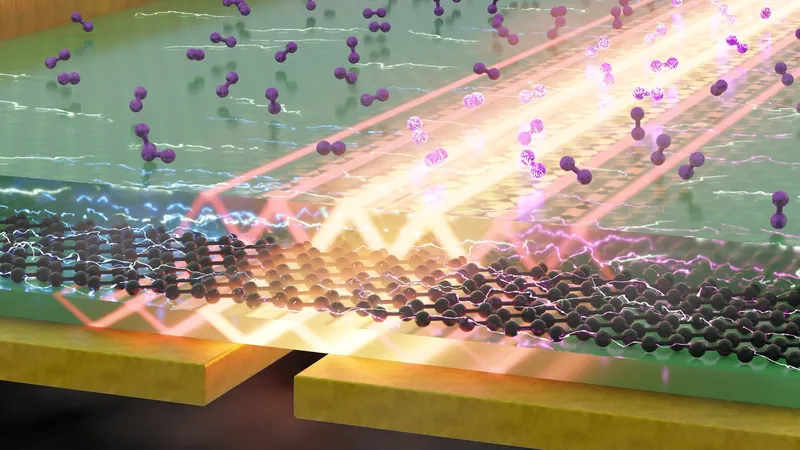
Breakthrough On-Chip Device Revolutionizes Molecule Detection Using Exotic Light Rays!
2024-11-18
Author: Nur
Researchers have unveiled a groundbreaking on-chip device that significantly enhances the ability to detect molecules by tapping into their unique infrared vibrational "fingerprints." This advanced detector cleverly transforms incoming infrared light into "nanolight," specifically utilizing phonon polaritons within its active area—an approach that dramatically increases sensitivity and allows for precise analysis of thin molecular layers.
The implications of this technology are immense. Operating at room temperature, the compact design of the detector signifies a leap towards developing ultra-compact platforms for applications in molecular and gas sensing. The study detailing this innovation has been published in the prestigious journal *Nature Communications*, highlighting its potential to redefine how we sense and analyze materials.
Understanding the concept of molecular fingerprints is crucial. Each molecule resonates at a distinct frequency when illuminated with the right light, particularly in the infrared range. This intrinsic behavior can be compared to human fingerprints, as it allows scientists to differentiate between various substances effectively. This capability is especially valuable for identifying dangerous or toxic materials in our surroundings, much like how law enforcement uses fingerprints to identify criminals.
Traditionally, infrared fingerprint spectroscopy has been employed to identify molecules based on their infrared reflection or transmission spectra. Nevertheless, the challenge arises from the small scale of organic molecules relative to the infrared wavelength, which produces weak scattering signals and complicates detection for tiny material quantities.
Recent advancements have seen the emergence of Surface-Enhanced Infrared Absorption (SEIRA) spectroscopy, which amplifies molecular vibrational signals using rough metal surfaces or metallic nanostructures, making it easier to analyze minute quantities. Despite these advancements, SEIRA has been constrained by bulky, far-field techniques requiring substantial equipment, such as nitrogen-cooled infrared detectors, which limits flexibility and miniaturization.
In an innovative turn, phonon polaritons—excitations that merge electromagnetic waves with atomic lattice vibrations—have shown great promise in enhancing the sensitivity of additional spectroscopic techniques. Specifically, hyperbolic phonon polaritons in two-dimensional hexagonal boron nitride (h-BN) layers have gained considerable attention for their potential applications. As Prof. Rainer Hillenbrand from Nanogune notes, their long lifetimes and exceptional field confinement could transform how SEIRA spectroscopy operates.
Now, a dedicated team has successfully developed the first on-chip phononic SEIRA detection system specifically designed for observing molecular vibrations, thus eliminating the need for traditional large-scale infrared detectors. This achievement was a collaborative effort, utilizing both experimental results from Nanogune and ICFO, along with theoretical input from prominent institutions.
What's particularly thrilling is that the new graphene-based detector can ultimately pave the way for the miniaturization of molecular sensing technologies. As ICFO researcher Dr. Sebastián Castilla explains, integrating this technology with microfluidic channels could lead to the creation of a true “lab-on-a-chip.” This innovation holds the potential for rapid identification and analysis of specific molecules in tiny liquid samples, advancing the field of medical diagnostics and environmental monitoring like never before.
In a world where rapid molecular detection can be critical for health and safety, this novel device presents a significant step toward a new era of efficient, customizable, and practical sensing solutions. Stay tuned as this fascinating technology continues to develop, with potentially game-changing impacts across numerous scientific fields!



 Brasil (PT)
Brasil (PT)
 Canada (EN)
Canada (EN)
 Chile (ES)
Chile (ES)
 España (ES)
España (ES)
 France (FR)
France (FR)
 Hong Kong (EN)
Hong Kong (EN)
 Italia (IT)
Italia (IT)
 日本 (JA)
日本 (JA)
 Magyarország (HU)
Magyarország (HU)
 Norge (NO)
Norge (NO)
 Polska (PL)
Polska (PL)
 Schweiz (DE)
Schweiz (DE)
 Singapore (EN)
Singapore (EN)
 Sverige (SV)
Sverige (SV)
 Suomi (FI)
Suomi (FI)
 Türkiye (TR)
Türkiye (TR)